Approaches to product growth changed when growth hacking came onto the scene more than a decade ago. But like any influential concept, growth hacking has inspired criticism, diverse schools of thought, and more than a few misconceptions.
As we describe here, there is no authoritative, one-size-fits-all definition of growth hacking. But in the most general terms, it is a process aimed at communicating the key value of a product to the largest possible audience. These efforts span the entire product and marketing funnel and involve software engineers, designers, and analysts. A number of spin-off methodologies and frameworks have emerged containing many of the same principles.
In this article, we’ll cover:
- Where growth hacking came from
- First examples of successful growth hacking
- Myths surrounding growth hacking
- Legacy and evolution of the growth hacking concept
Follow along for a chronological look at the events, talks, and key essays that have shaped the history of growth hacking.
→ Test your product management and data skills with this free Growth Skills Assessment Test.
→ Learn data-driven product management in Simulator by GoPractice.
→ Learn growth and realize the maximum potential of your product in Product Growth Simulator.
→ Learn to apply generative AI to create products and automate processes in Generative AI for Product Managers – Mini Simulator.
→ Learn AI/ML through practice by completing four projects around the most common AI problems in AI/ML Simulator for Product Managers.
Why growth hacking was needed
Growth hacking started as a reaction to the problem of how to divide responsibilities between product and marketing teams. Historically, product and marketing have been siloed off from each other. The product team would work on the core value of the product, which is to say on achieving and strengthening product/market fit. In parallel, marketing, PR, and sales teams would surface this value to users from the target market through traditional promotional channels.
But with digital products, these boundaries began to blur. Some tasks straddled these silos and it wasn’t clear who to assign them to. Things became even more complicated with viral mechanisms and large platforms, which were simultaneously an important part of the product and a channel for distributing it.
One attempt to solve this problem, before growth hacking came along, was Facebook’s growth team in 2007–2009.
History of Facebook’s growth team
A key figure in this story was Chamath Palihapitiya, then an eccentric ex-AOL employee who had joined Facebook in 2007. Steven Levy, the author of Facebook: The Inside Story, has a post with all the details about how Palihapitiya set the growth challenge for Facebook and assembled the first growth team. Here we’ll give just an outline of these events with information added from other authoritative sources.
Palihapitiya began assembling a growth team in early 2008, when Facebook’s audience had plateaued at 90 million users. Conventional wisdom said that social products could not break a ceiling of 100 million monthly active users. And it seemed that Facebook, although a promising startup, was going to prove this rule yet again.
Stagnant growth inspired a search for new strategies. The growth team at that point included Naomi Gleit, Alex Schultz, and Javier Olivan, who continue to work at Meta in senior roles.
Palihapitiya formulated the general approach to achieving growth in his famous talk “How we put Facebook on the path to 1 billion users” with three questions:
- How do you get people to the front door?
- How do you get them to an “aha moment” as quickly as possible?
- And then how do you deliver core product value as often as possible?
The “aha moment” is the moment a user first experiences the key value of a product. For Facebook, it was a user adding seven friends over a 10-day period.
The company went on to define a North Star Metric reflecting the value that the product creates for users and the world. The team would refer to this vital high-level metric in order to gauge success. For this metric, they settled on MAU—or MAP, Monthly Active People, as Facebook called it, in order to emphasize that we are talking about real people, not just numbers. In his talk, Alex Schultz goes into detail on the priorities of Facebook’s growth team at the time.
In effect Facebook’s growth team was a full-fledged product team with developers and designers who conducted a lot of experimentation and product tinkering guided by the North Star Metric. Importantly, this team did not touch the core of the product. They worked on delivering existing value to users.
One experiment with a significant impact on growth was the addition of People You May Know (PYMK). For PYMK to work, Facebook requested access to the user’s address book—back then, the main source of contacts was email. New users would immediately see a list of people they already knew, which made it easy to add friends on Facebook and experience an “aha moment” more quickly.
This led to some controversies, however. For example, PYMK suggested that clients of the same psychologist friend each other. Such situations called into question the extent to which Facebook sacrificed users’ privacy in the name of growth. The Financial Times, among others, wrote about Facebook’s response to the concerns of regulators and activists.
It is worth reiterating that the purpose of PYMK was not to provide users with new features or create new value, but to help them understand the value of а product they were already using.
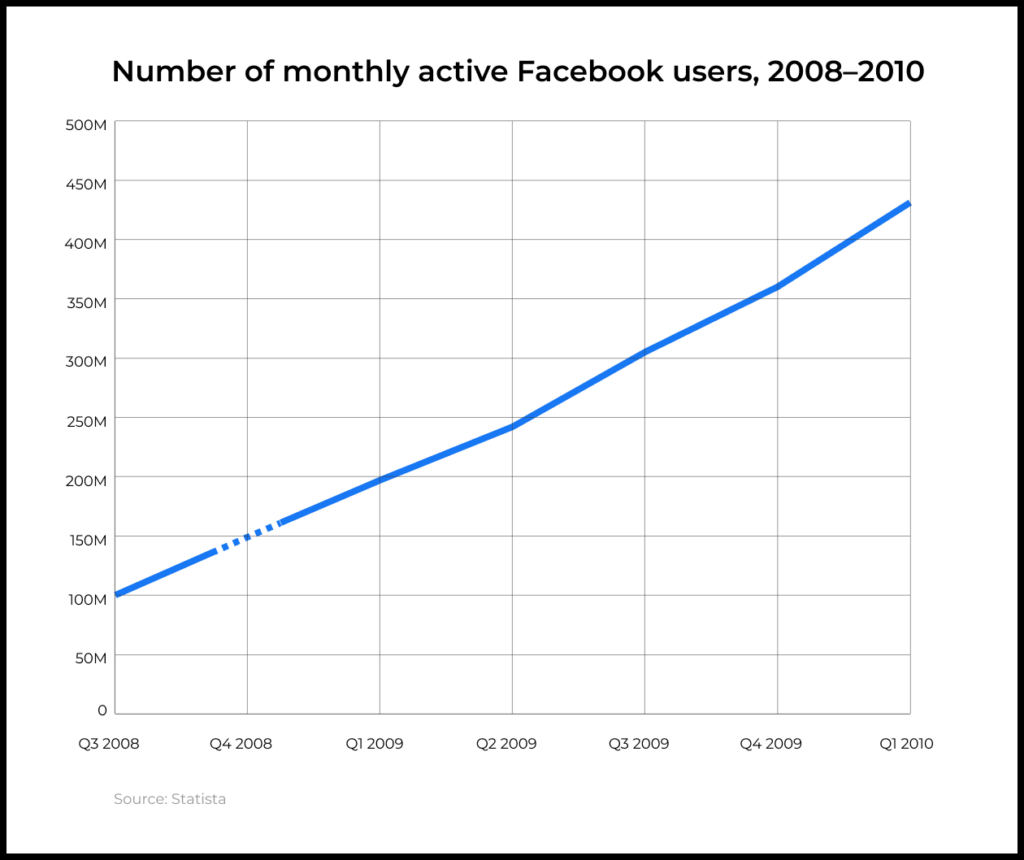
Facebook’s story is one example of how a team at the intersection of marketing and product generated growth in a way that was unconventional for its time. Other companies, like LinkedIn, tried this as well but such cases were the exception, not the rule.
Origin of the “growth hacking” term and concept
In July 2010, Sean Ellis published his essay “Find a Growth Hacker for Your Startup”. He analyzed the challenges of growth and scaling for startups. The most common mistake for startups is to hire people with skillsets completely irrelevant to jumpstarting growth, he wrote. Sean Ellis posited the solution to the problem this way:
“So rather than hiring a VP Marketing […], I recommend hiring or appointing a growth hacker.”
So who are growth hackers and what do they do, according to the essay?
The job of a growth hacker is to drive growth. Everything the growth hacker does centers around this. They operate at the intersection of product and marketing as they prioritize ideas, test them, and determine which ones work.
In the first essay on growth hacking, Ellis emphasizes the disciplined, incremental nature of the growth hacker’s work. As we will see later, many lost sight of this aspect as they gravitated toward one-and-done shortcuts and “growth hacks”.
The growth hacker concept articulated by Sean Ellis was largely based on his personal experience of growing companies that ultimately became billion-dollar businesses.
Dropbox growth story
Sean Ellis joined the Dropbox team in 2008. Before that, he led marketing at LogMeIn, which had developed a remote computer access product of the same name. Although the two products solved a similar problem—remote access to files—Sean realized that his LogMeIn experience wouldn’t translate directly to Dropbox.
LogMeIn was growing largely through paid advertising channels (particularly search advertising) and had reached 100 million connected devices by the time Sean left the company. This was possible because there was a clear and established market demand for remote access products, thanks to which people were looking for them online.
But for Dropbox, paid search was not working. People had no idea about this way of doing things and therefore were not looking for it with search engines.
Studying user behavior led Sean and the team to believe that growth could be built with virality, based on patterns in how existing audiences interacted with the product.
The core of Dropbox’s growth model was built around two important use cases. The first involved using Dropbox to store data as well as share files with other users. But the problem was that on the free tier, each user was limited to 2 GB of storage. So Dropbox decided to launch a referral program, rewarding both the inviter and invitee with additional storage space.
The second important channel was built-in (organic) virality when users shared files. This was a great opportunity to introduce other users to the product and help them to realize its value.
A rough estimate of the impact of the referral program and organic virality can be seen in the chart below (we were unable to establish the source of the chart data):
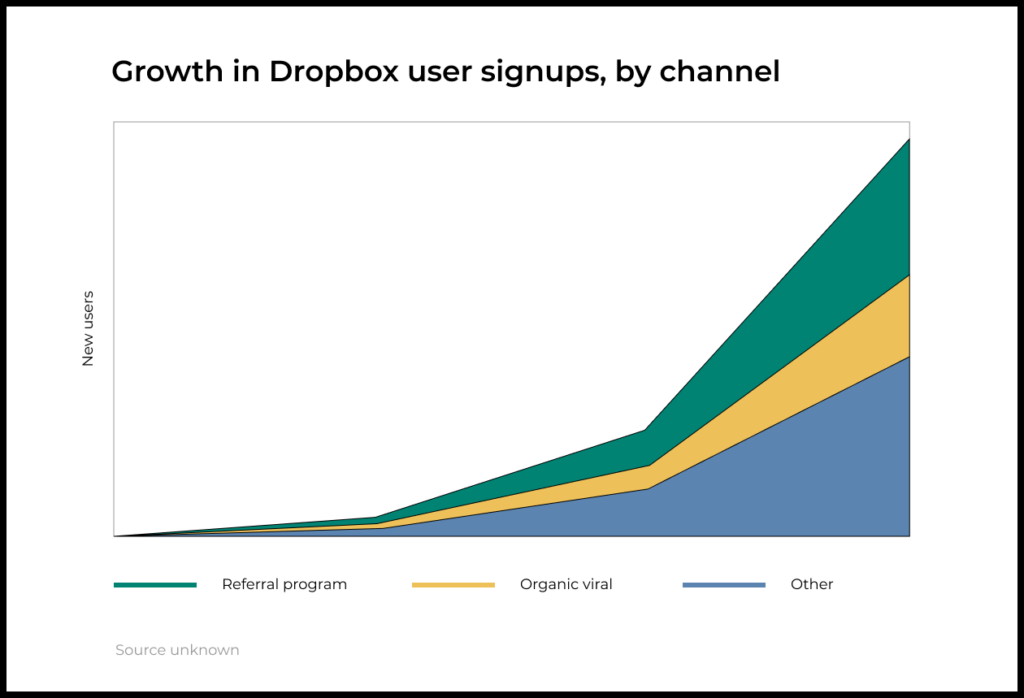
In an interview, Ellis acknowledged that the biggest driver of Dropbox’s long-term growth was probably not the referral program, but dozens of smaller low-profile experiments. But in any case, the result is that in just 15 months, by early 2010, Dropbox had grown from 100,000 to 4 million users.
Growth hacking gains industry recognition
In 2012 Andrew Chen popularized and expanded on the role of growth hackers in two essays: “Growth Hacker is the new VP Marketing” and “You don’t need a growth hacker”. A California-based entrepreneur and blogger at the time, Andrew Chen is currently General Partner at venture fund Andreessen Horowitz.
“Growth hackers are a hybrid of marketer and coder, one who looks at the traditional question of ‘How do I get customers for my product?’ and answers with A/B tests, landing pages, viral factor, email deliverability, and Open Graph. On top of this, they layer the discipline of direct marketing, with its emphasis on quantitative measurement, scenario modeling via spreadsheets, and a lot of database queries.”
Chen’s first essay revolves around the observation that marketing channels and marketing in general have changed. Marketing used to depend on traditional channels with a large reach, such as newspapers and television. Companies didn’t have direct access and instead relied on gatekeepers, in the form of advertising and PR agencies. But now there were digital platforms reaching tens of millions of users, such as Facebook and Apple. Their emergence sparked the need to transform marketing VPs into growth hackers, who can promote a product using APIs rather than the classic marketing toolkit.
In the second essay, Chen makes an even more profound point: early-stage startups don’t need growth hackers at all. Startups need product/market fit, not growth. Growth follows product/market fit.
“Similarly if your product isn’t retaining users, it won’t help much to pour water into a leaky bucket.”

Ellis and Chen made such valuable contributions not because they came up with the concept from scratch, or even because they analyzed examples of successful growth hacking (in his first piece Chen details the Airbnb case, which we will come to in just a bit). The value was that they succeeded in explaining why growth hacking had become possible at that precise moment, what the prerequisites for it are, when growth hacking makes sense for startups, and which kinds of talent are needed to fill these roles.
They did not offer any recipes or silver bullets. However, as growth hacking caught mass interest, less scrupulous self-proclaimed experts were ready to take advantage.
How growth hacking caught on—and got a bad name
A sidenote: Although we have been using the term “growth hacking”, at the time in question, this term was rather less common than the one referring to its practitioners, “growth hackers”.

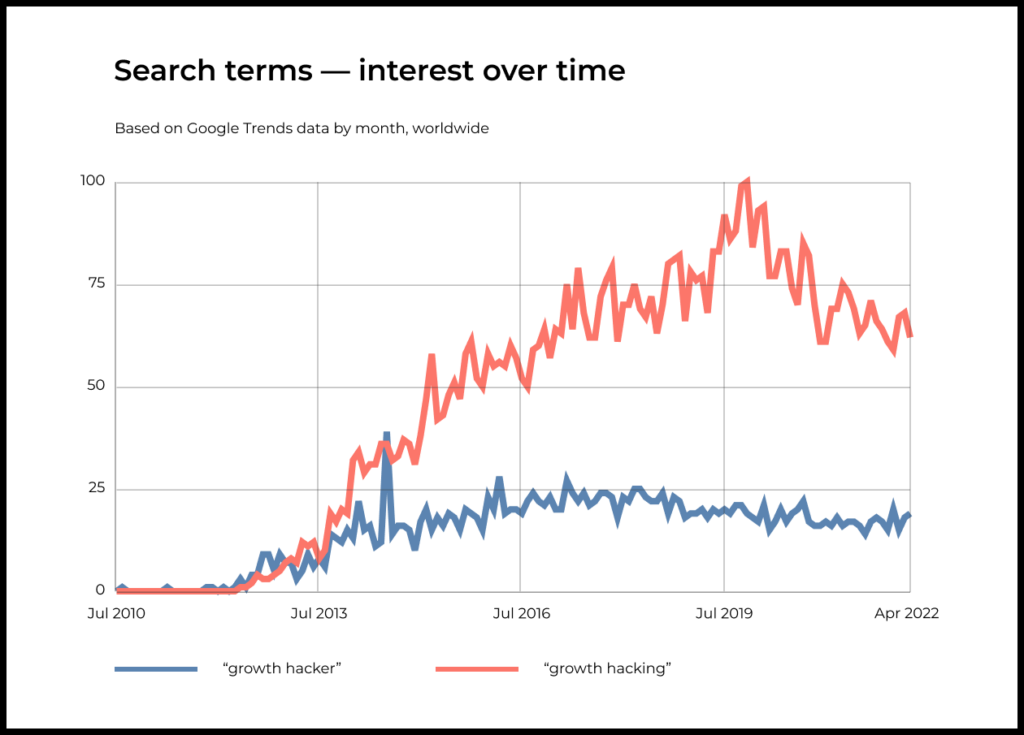
As buzz picked up in 2012, growth hacking went from a niche concern to an interest for IT and business in general. The mysterious, semi-mythical “growth hacker” turned into a more formalized role.
Widely reported cases, such as that of the Airbnb growth hack, played a key role in this.
Story of the Airbnb growth hack
Like any new marketplace, Airbnb started out with a “chicken and egg problem“. Users won’t look for rental housing on a site that doesn’t have any listings, and landlords won’t list anything on a site with no users.
At that time, Craigslist was a popular site for classified ads, including short-term rentals.
Airbnb began looking for ways to convince Craigslist posters to list their rentals on Airbnb. To lure landlords, Airbnb created a special bot that emailed landlords who had recently posted on Craigslist with an offer to list their rental on Airbnb as well.
The Craigslist site inadvertently made it easy to implement Airbnb’s growth hack. Craigslist stored all of a listing’s data inside a unique URL, instead of a cookie. This made it trivial for the bot to pre-fill a listing page and let the landlord publish it on Airbnb by simply clicking a link.
Another tactic was for landlords to receive emails from “young ladies” raving about how great Airbnb is. You can read the full story of the experiments that led to the discovery of the team behind these coordinated emails. The essay inspired scrutiny of the factors behind Airbnb’s explosive growth.
Airbnb’s experiments can be viewed in two ways. On the one hand, they certainly provided a successful supply-side solution to the “chicken and egg problem” by increasing the housing listings on the site. But on the other hand, can this kind of behavior really be called “fair play”? Growth hacking, at least in the ways we’ve discussed, did not involve exploiting vulnerabilities in other products for one’s own benefit or using other underhanded tactics.
But for some, impressive numbers outweighed potential ethical concerns. This appetite for quick hacks and silver bullets gradually began to discredit growth hacking as a whole.
Myths about growth hacking and dark patterns
A few myths about growth hacking were dissected in late 2012 on TechCrunch. Here are some of them:
- Growth Hacking Is A Cheat Sheet Of Secrets On Growth
- A Growth Hacker Is A Quick Fix For A Company’s Problems
- A Growth Hacker Is A Coder
- A Growth Hacker Is Just An Individual
These myths are based on statements that have been taken out of context or exaggerated. Growth hacking is not a set of secrets or a patch that can be slapped onto any product. It’s a holistic process and strategy that requires a custom approach to each company and product.
As Sean Ellis points out, the word “hacker” does not mean you have to be a coder. Although Andrew Chen also used the word “coder” in his essay, the key point was that a growth hacker cannot be afraid to get into the product. Code can be a tool for doing this, but it’s not always necessary—coding tasks can always be delegated to a more competent specialist.
And of course, the growth hacker is always part of a team and a process, never a lone warrior.
However, many shady practices known as dark patterns claimed to be inspired by growth hacking. Here are a few examples of such patterns from another TechCrunch piece:
- Rap Genius (currently known as Genius) is a site that publishes song lyrics, related user annotations and interpretations, and music news. In December 2013, the company invited bloggers to participate in a “blog affiliate” program: a blogger would link to (for example) Justin Bieber lyrics on Rap Genius, and in return, Rap Genius would promote the blogger’s posts on social media. This large number of backlinks would push Rap Genius to the top for popular song-related searches. But the tactic was quickly uncovered and Google retaliated by severely downgrading the site’s position in search results. Weeks later, the two companies made peace and the Rap Genius founders apologized.
- For some startups, growth hacking turned into something quite narrow: spamming as many people as possible in the hope of converting them into users. For example, the video messaging app Glide, launched in March 2013, followed this path in an attempt to raise virality. After gaining access to a user’s contact list, Glide sent clickbait messages to contacts with a link to download Glide. Needless to say, recipients were not thrilled by this hyperaggressive approach.
Although these examples go back to 2013, dark patterns themselves have not gone anywhere. They are particularly common in subscription-based products. Once very common, such dark patterns draw the user into a free trial and obtain their credit card number in the process. By design, some users will forget to cancel their subscription before the trial ends.
Another dark pattern is the roach motel. This happens when a product streamlines the onboarding and subscription process, but creates obstacles to discourage users from unsubscribing. Such practices have been used by the New York Times, as described by Nir Eyal, author of Hooked. The option to unsubscribe from the New York Times is hidden deep in the newspaper’s interface. But there is no button that will actually end the subscription—the subscriber must either call or talk to a live chat specialist. The operator will ask a number of questions and make several suggestions before finally unsubscribing the user. When dark patterns get passed off as growth hacking, it’s easy to understand the concern behind questions like “Is Growth Hacking nonsense?” on Quora or essays titled “Growth hacking is bullshit”. Still, it’s important to note that these criticisms tend to target not growth hacking per se, but certain questionable interpretations of it.
From growth hacking and growth hacks to growth as a strategy
Growth hacking had become a divisive topic. Was it fair to call the concept “bullshit”?
Brian Balfour, then VP of Growth at HubSpot and later the founder of Reforge, took a broader view in his April 2014 essay.
In his analysis, there are three key sources of criticism of Growth Hacking:
- From growth teams, who have been involved in product growth for many years and do not understand the novelty of growth hacking.
- From those annoyed by the hype artists who took advantage of interest in the topic just to get their name out.
- From those upset by the dark patterns all too often labeled as “growth hacks”.
But none of these truly matters in the bigger picture. Truly attention-worthy are the fundamental changes in how technology companies identify and act on growth opportunities.
Traditionally, different teams and specialists have been responsible for different stages of the AAARRR funnel (Awareness, Acquisition, Activation, Retention, Revenue, Referral). Per Balfour, the first two stages are the responsibility of marketing, while the product team is responsible for activation and user retention and the sales team is responsible for revenue.
Growth, as an approach that blends product, marketing, and development, changes the way we look at this funnel. The growth team works at every stage of the funnel, because growth can be shaped at each of these stages. This approach requires deeply integrating development, design, and data.
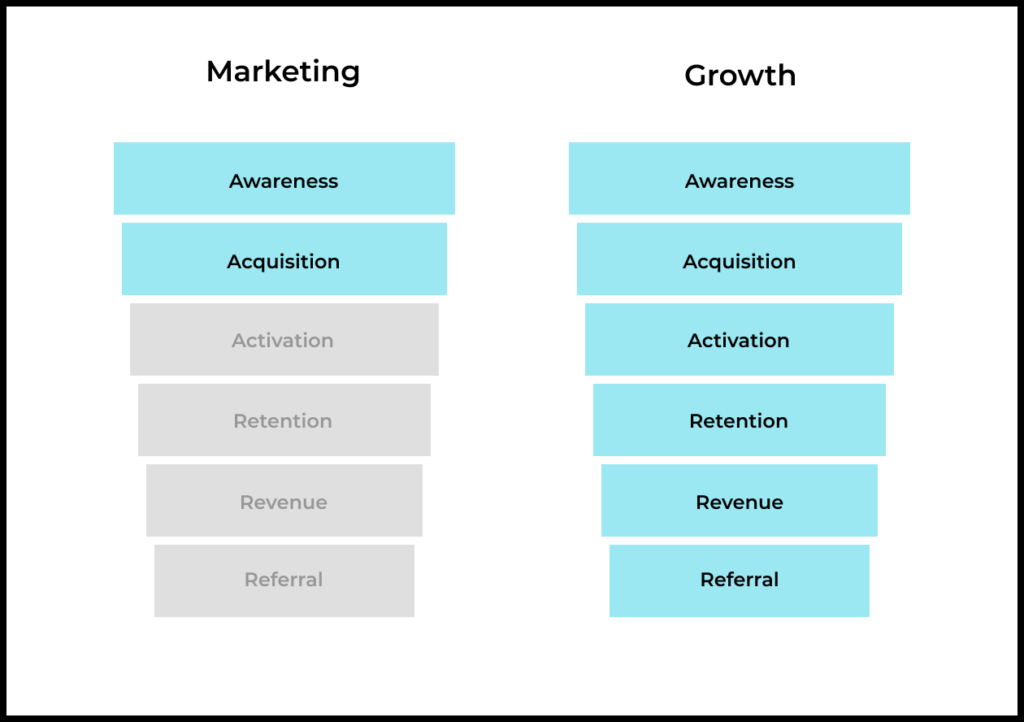
The framework that Chamath Palihapitiya invented for Facebook, from the perspective of the product and growth teams, would look like this:
- The product team creates core value.
- The growth team communicates this value to as wide an audience as possible.
- Together, they work to ensure that the user experiences this core value as often as possible.
Much of Balfour’s take matches what we have already discussed here. But the value of his material is precisely that he presents a systematic view of growth as a strategy, not a set of tactics. Teams should focus on these tasks instead of getting sidetracked by terminology.
“Call it growth, growth hacking, quantitative marketing, full stack marketing, technical marketing, or whatever you want. Growth, in my opinion, far less about the terminology or tactics. It is more about a change in our mentality, process, and team structure of how we grow a technology company.”
Growth without “hacking”
Growth hacking eventually grew up and stopped being the hot new thing. The word “growth” could now stand by itself, free of association with hacking or loopholes. Originally the preserve of the tech and IT crowds, growth became a concern for business at large.
One marker of the paradigm shift was the February 2016 publication of “Every Company Needs a Growth Manager” in Harvard Business Review. The topic of growth had risen up from blogs, social media, and corporate conferences to business periodicals with a broad readership.
By then, the generic title of “growth hacker” had given way to new job titles for specific roles. These titles varied depending on the company, skillset, and responsibilities. But they all contained some variation on “growth”: Growth Manager, Growth Marketer, Growth Marketing Manager, VP of Growth, Head of Growth, Growth Lead, and others. These positions attracted increasing attention from both employers and applicants.

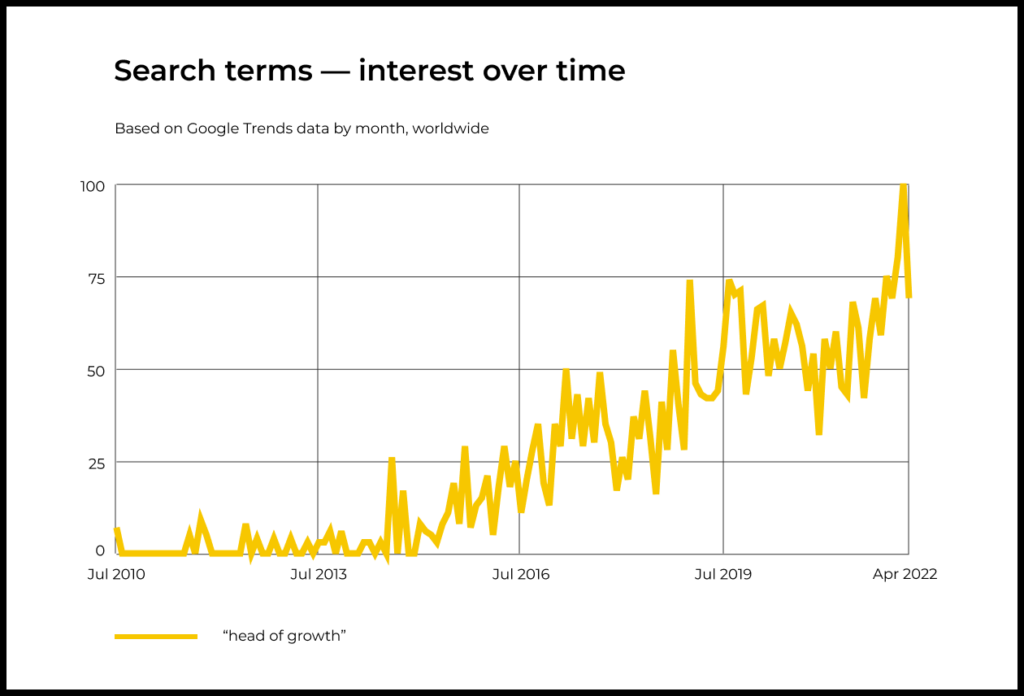
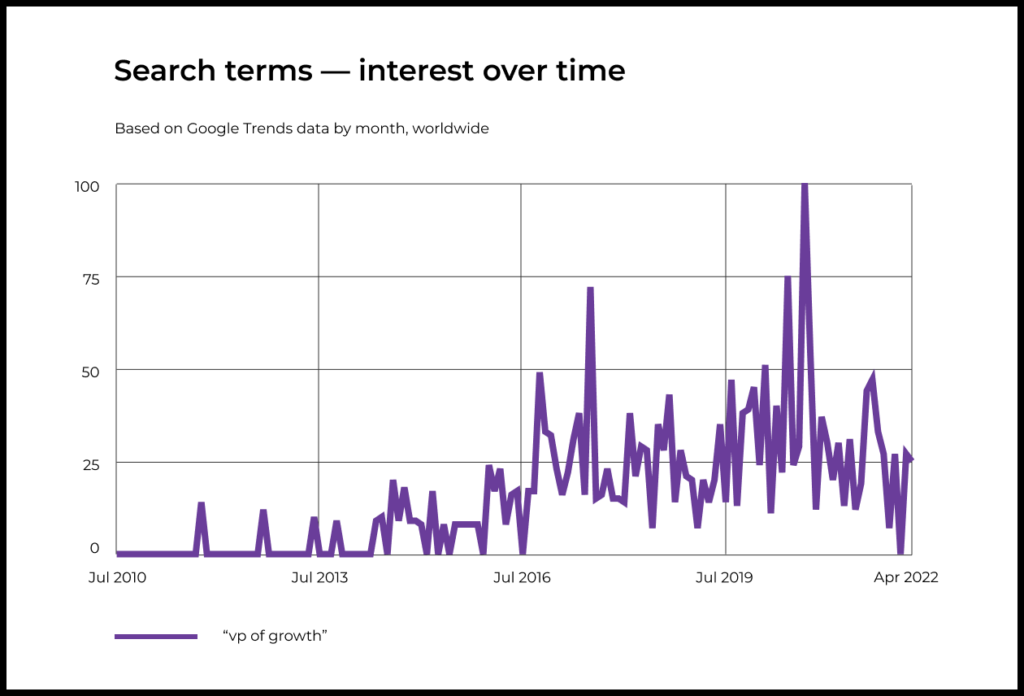
Diverse approaches to growth inspired not just new job titles, but new strategies as well.
Offshoots of growth hacking
One methodology growing out of the core principles of growth hacking is Product-Led Growth. According to PLG, the main growth driver of a product is the product itself, not the sales team. Growth then depends on how well and how quickly the product communicates value to the user, and how much it inspires word-of-mouth.
In an ideal Product-Led Growth world, the product would sell itself and all the teams—development, marketing, sales, and design—would simply work to improve the user experience. In this sense, Product-Led Growth takes after the basic principles of growth hacking by pursuing growth through cross-functional integrated teams at all stages of the funnel.
Of course, Product-Led Growth and other methodologies do not claim to apply to every case. Some businesses have found other frameworks and team structures to be more effective. Product-Led Growth, for example, is most relevant for B2B SaaS products, but may not apply as well in other areas. Community-Led Growth with its emphasis on a growing community of active users gained popularity in 2021, but it will not work for products where user-to-user communication does not carry significant value.
Like growth hacking and other trendy concepts, new methodologies and frameworks always have to go through a hype phase. Through trial and error, each will eventually find their niche and area of applicability.
Why growth hacking remains relevant
In this essay, we have explored key milestones in the creation and development of growth hacking.
Growth hacking by its nature does not say exactly what to do. It does not give precise recipes. What it offers is a lens for looking critically at a product and its growth. Naturally, like any concept that refuses a one-size-fits-all approach, it has evolved and matured over time.
The job titles responsible for growth may change. The tasks and priorities of product managers will vary based on context and corporate goals. Many of the principles for growth are timeless and can be tuned to the needs of specific niches and markets, generating new and finely targeted methodologies.
And even now, when it comes to growth for digital products, we think that the core principles suggested by growth hacking have a lot to offer.






